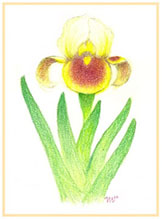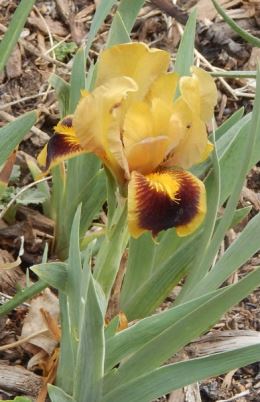|

|
Arilpums
|
 This
fertile family consists of amphidiploid arilbred dwarfs with two sets
of 8 chromosomes from I. pumila and two sets of 10-11 aril
chromosomes. A few members of this family were produced in the
mid-20th century by crossing I. pumila with the tetraploid
Regelia species Ii. hoogiana and stolonifera. More
recently, Harald Mathes produced 'Barbarella' and Francesca
Thoolen gave us 'Aladdin's Gem', both
from tetraploid regeliocycli or oncogelias derived from
colchicine-induced tetraploids. Oddly, both are pollen
fertile only.
This
fertile family consists of amphidiploid arilbred dwarfs with two sets
of 8 chromosomes from I. pumila and two sets of 10-11 aril
chromosomes. A few members of this family were produced in the
mid-20th century by crossing I. pumila with the tetraploid
Regelia species Ii. hoogiana and stolonifera. More
recently, Harald Mathes produced 'Barbarella' and Francesca
Thoolen gave us 'Aladdin's Gem', both
from tetraploid regeliocycli or oncogelias derived from
colchicine-induced tetraploids. Oddly, both are pollen
fertile only.
Although it is reported that Peter
Werckmeister and others have raised large numbers of fertile
seedlings in this family, none of them are presently available in
commerce. Hence this fertile family must be enlarged by creating new
pumila x tetraploid aril hybrids and interbreeding them.
Ideally, these crosses should be made using the widest possible range
of both parental types.
This is a major focus of my hybridizing
plans, and my primary reason for acquiring a solid collection of
I. pumila and of the tetraploid arils. It would be a shame if
this intriguing family of irises, with so much unrealized potential,
were to dwindle away because so few varieties are
obtainable.
Because this group is so limited at the
moment, I am willing to try some unconventional approaches to
expanding it:
1. APP triploids: These are
produced by crossing diploid arils with I. pumila. Three were
produced and introduced by Jonnye Rich. With this approach, it is
possible to introduce diverse oncocyclus genes into the arilpums
directly, instead of going through the strongly regelia-influenced
tetraploid arils currently available. Although the triploids are not
expected to be fully fertile, they may have enough fertility to breed
with existing AAPP arilpums and expand the family.
Additionally, there is the hope that the onco x pumila cross
might produce an AAPP seedling from an unreduced aril
gamete.
2. AAP triploids: This is
similar to approach #1, but the cross is that of diploid aril x
arilpum.
3. AP diploids: I would like to
try crossing I. attica with diploid arils. The rationale is
the same as using the triploids, although in this case the seedlings
would be expected to be sterile, with the rare exception of unreduced
gametes.
4. Unbalanced tetraploids (AAPT):
There are a few unbalanced tetraploids of this sort, including
Lawrence Ransom's "Vera girls" and possibly the antique
'Zwanenburg'.
The P and T sets seem to have more affinity with each
other than either do with the arils, so occasional fertility is
possible. Gametes would be either AP or AT (give or
take a chromosome or two), and so should produce about half AAPP
amphidiploids when crossed with the existing members of the
family. The APPT unbalanced tetraploid 'Persian Sapphire' also
has the potential to produce AP gametes.
Progress to Date
See my AIS blog posts, below. I now have many
arilpum seedlings under evaluation, and many are fertile, with
second-generation seedlings on the way.
Hall of Fame
Miltonia (Werckmeister). .../OGB/ABD.
('Teucros' x I. susiana) X I. pumila.
This unregistered arilpum was produced in the
early 1960s from crossing an oncogelia seedling with I. pumila.
The aril parent apparently produced an unreduced gamete, making
'Miltonia' a fertile amphidiploid. Although Paul Cook had introduced
'Hoogpum Blue' and 'Hoogpum Purple' in 1956, it was Miltonia that
demonstrated the potential for an arilpum fertile family with
oncocyclus flower characteristics. It produced a couple registered
offspring, but alas the further amphidiploid arilpums it produced
have been lost.
Barbarella (Harald Mathes, R. 1991).
Sdlg. AP-BSF. AB/OGB/ABD, 12” (30 cm), E. S. smooth gold,
flushed darker at midrib; F. same; large signal spot and veining of
dark mahogany; bright yellow beard. Unregistered tetraploid RC
seedling X "Chocolate Heart", yellow pumila; garden name:
["Schokoladenherz"]. Aril Society, 1991.
Harald Mathes's 'Barbarella' was the first
arilpum to be registered from tetraploid RC x I. pumila
breeding. It is pollen fertile, and has been crossed with SDBs
and ABs to produce some arilbred medians of note.
Aladdin's Gem (Francesca
Thoolen, R. 2001). Sdlg. AP9303.
AB/OGB/ABD, 10" (25cm), E. S. muted yellow; style arms yellow; F.
yellow, large maroon spot; beards yellow. AR8701: ('Tel Hashi' x
Holden Ht28-T: (Norris T-N81N: (Norris T-N79P: (('Kerr's Wide Falls'
x I. basaltica) x (Bushey B66J2: (sib x 'Kerr's Wide Falls') x
Bushey B66M3: ('Kerr's Wide Falls' x ('Charon' x 'Teucros')))) x
'Persian Pansy') x Norris T-N79P: (Norris C-N76RP: ('Kerr's Wide
Falls' x I. basaltica) x Norris C-N76RM: (Bushey B66J2: (Kerr
K53-44DF x 'Kerr's Wide Falls') x Bushey B66M3: ('Kerr's Wide Falls'
x Austin H-18: ('Charon' x 'Teucros')))))) X 'Brownett'. Aril Society
2002.
Ten years after 'Barbarella', Francesca
Thoolen introduced 'Aladdin's Gem', an amphidiploid arilpum which
strongly shows its oncocyclus heritage in flower form and color
pattern. Its pollen is fertile, but it has not produced any
registered offspring to date.
Further Reading
Bearded Species for
Breeding Arilbred Medians
Arilpums: Fertile
Arilbred Dwarfs! (AIS blog)
Progress
with Arilpums (AIS blog)
Arilpums
Are Here! (AIS blog)
Gallery

|

|
'Aladdin's
Gem'
(Thoolen 2002)
|
'Topaz
Talisman'
(Jensen, 2015)
|
Plant List
The list below shows the name of each plant I
currently grow, the source, and the year acquired.
Illustration: 'Aladdin's
Gem' (Thoolen '02), a fertile arilpum from a tetraploid oncogelia
seedling x 'Brownett'.
Tom
Waters
September 2010
updated April
2023
Unless otherwise noted, all text
and illustrations copyright Tom Waters and all photographs copyright
Tom or Karen Waters. Please do not reproduce without
permission.
 This
fertile family consists of amphidiploid arilbred dwarfs with two sets
of 8 chromosomes from I. pumila and two sets of 10-11 aril
chromosomes. A few members of this family were produced in the
mid-20th century by crossing I. pumila with the tetraploid
Regelia species Ii. hoogiana and stolonifera. More
recently, Harald Mathes produced 'Barbarella' and Francesca
Thoolen gave us 'Aladdin's Gem', both
from tetraploid regeliocycli or oncogelias derived from
colchicine-induced tetraploids. Oddly, both are pollen
fertile only.
This
fertile family consists of amphidiploid arilbred dwarfs with two sets
of 8 chromosomes from I. pumila and two sets of 10-11 aril
chromosomes. A few members of this family were produced in the
mid-20th century by crossing I. pumila with the tetraploid
Regelia species Ii. hoogiana and stolonifera. More
recently, Harald Mathes produced 'Barbarella' and Francesca
Thoolen gave us 'Aladdin's Gem', both
from tetraploid regeliocycli or oncogelias derived from
colchicine-induced tetraploids. Oddly, both are pollen
fertile only.

